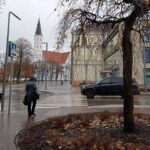The ascension of leftist leader Gabriel Boric in Chile as the nation’s new president in October 2021 was widely believed to represent a broader fast-rising left-wing political shift across Latin America, following the left-wing’s sweep into power in Mexico, Argentina, Bolivia, Peru and Honduras.
With former Brazilian leader Luiz Inacio Lula da Silva expected to make a comeback in Brazil’s elections this year, Latin America looks set to see a new wave of a “Pink Tide,” observers said, adding that the COVID-19 pandemic has, since 2020, prompted a resentment of neoliberal policies in Latin America, helping the left to gather momentum and expand its base. The leftward turn in politics, akin to the “Pink Tide” a decade ago, reveals not only local people’s suffering amid the pandemic, but also a deep-rooted inequality that was reflected in riots in Chile in 2019.
The “leftward” shift in Latin American politics has been evident, said Zhou Zhiwei, an expert on Latin American studies at the Chinese Academy of Social Sciences. The return of the left is not surprising, he argues, given the nature of the left-right pendulum in Latin America’s political landscape, though it is worth noting that this time the “right-to-left” shift has come earlier than expected.
Experts say the rejuvenated “Pink Tide” may favor China in economic investment and closer political cooperation across Latin America, which makes China’s access to more opportunities and the gaining of more support from the region far more likely.
The return of the left
So far, at least 15 of Latin American countries and regions have been governed by left-wing or center-left leaders.
Boric, a 35-year-old leftist, is a highly unusual presence in Chile, a country that has been steeped in neoliberalism for decades and where elections have always been a contest between the right and the far right. Ahead of Boric’s victory in Chile, Brazil is witnessing a greater uncertainty for the upcoming 2022 elections as Brazil’s most notable political leader, former President Lula, announced that he will run for office, and is currently leading in the polls. Lula was forthright about his future – “I’m back in the game. I want to play, and I want to win.”
Brazil’s inflation rate accelerated more than previously expected, leaving the region’s biggest economy struggling against a plunging currency and a stalled pandemic recovery under the current policies of far-right President Jair Bolsonaro, also known as the “Donald Trump of Brazil.” That has pushed Lula surging past Bolsonaro in polls.
Since 2021, leftist leaders won elections in Peru, Honduras, and Chile. Before that, left-wing leaders had won political office across the region including in Argentina, Bolivia, and Mexico.
The expected return of the left in Brazil, the region’s biggest country, will help propel the wave to its peak.
In Honduras, the ruling right-wing government suffered defeat for the first time in a long while in a recent election, witnessing the ascension of the country’s first female president in history – Xiomara Castro. Notably, Castro is married to former Honduran president Manuel Zelaya, known for his bushy mustache and white cowboy hat. Zelaya was a contemporary of the late Venezuelan president Hugo Chavez on the Latin American left. Zelaya was ousted in a US-backed coup in 2009.
Although the left is gaining ground in Latin America, it has to focus on elections in Brazil and Colombia in 2022 to determine whether there will be an actual “Pink Tide,” Yang Jianmin, another expert on Latin American studies at the Chinese Academy of Social Sciences, told the Global Times. “Especially for Brazil, which accounts for more than 40 percent of Latin America’s economy, if the right stays in power and stands with the US, it’s hard to say whether left-wing politicians will completely take Latin America back again.”
“2022 is a big political year for Latin America… Latin American politics have already seen a decisive shift to the left in 2021 and it is not over yet. Right-wing incumbents look vulnerable and local currencies may suffer,” said a research report published by The ING Group, a Dutch multinational banking and financial services corporation, in November 2021.

Argentine President Alberto Fernandez (right) welcomes part of the 1 million doses of Chinese Sinopharm vaccines against the COVID-19 in Buenos Aires province, Argentina, on April 29, 2021. Photo: AFP
At the beginning of this century, the left-wing movement was at its peak in Latin America. However, former Venezuelan president Hugo Chavez, former Argentine president Nestor Kirchner, and other leftist leaders either passed away or left the political arena, leaving a vacuum for right-wing parties to seize power in many Latin American countries in 2014 and 2015. At the time, it was widely expected that this right-wing cycle would last for at least a decade or so.
Analysts believe the coronavirus disease pandemic in the region, which is responsible for causing serious problems of hunger and poverty, is one of the precipitating factors behind the acceleration of a left-wing political revival in Latin America. Yang said that Latin American right-wing politics in fact only lasted for three years (2015 – 2018). The upstart Latin American right was quickly defeated, particularly in the face of massive social protests against them.
The election of Mexico’s leftist candidate, Lopez Obrador, as president in July 2018 was a landmark event – the first time in 40 years that a leftist party had come to power in a traditionally pro-US Mexico.
Yang believes that COVID-19, which continues to spread in Latin America, has heightened public concern about economic recessions, poverty, corruption, insecurity, and low levels of employment. Right-wing policies, including cuts in the health sector, have played a negative role against the backdrop of the pandemic, which further increased social inequality.
The situation makes people reflect on the shortcomings of right-wing neoliberalism and the seeking of the positive role played by the government in economic development and distribution, which accelerated the “resurgence” of left-wing forces. The resurgence of Latin America’s left-wing is also a result of its estrangement from the US over the past years or so, especially under the Trump administration, Zhou said.
“When Latin America faces economic and livelihood issues, it does not receive a positive response from the US; Trump’s rejection and disdain of Latin American countries on matters like immigration also intensified the conflict between the US and Latin America to a certain extent. In the long run, ‘independent Latin America’ and ‘distancing itself from the US’ have become a political proposition by the left.”
A favoring environment for China
Experts believe that the emergence of leftist politicians in Latin America will expand China’s circle of friends in the region, based on the fact that Latin America will attach more importance to political and economic cooperation with China, given their closer ties in ideological and political values.
If the left wins Brazil’s general elections this year, the Community of Latin American and Caribbean States (CELAC) is expected to play a greater role in uniting Latin American countries, said Yang. “Enhanced regional integration in Latin America has made it easier for Chinese investment to enter the region, meaning more opportunities for all concerned.” However, he warned that some on the Latin American left might raise standards for foreign investment in environmental assessment, and some Chinese companies might face the risk of renegotiating contracts and the realignment of benefits.

Supporters of Chilean president-elect Gabriel Boric celebrate following the official results of the runoff presidential election, in Santiago, on December 19, 2021. Photo: VCG
Most of the left-wing politicians already in power in Latin America now take a more friendly view toward China. Argentina’s leftist President Alberto Fernandez, who took office in 2019, has announced that he will visit China and attend the 2022 Beijing Winter Olympic Games, despite a so-called political boycott against the Games orchestrated by some US-led Western countries. Argentina’s Foreign Ministry even posted a statement on its website saying it firmly supports the Beijing Winter Olympics.
“But that does not mean the US is losing Latin America,” Yang said. “The US is working hard to draw more Latin American leftists over to its side. The Biden administration has wooed them with high-profile promises of infrastructure and immigration aid, and has kept enhancing cooperation with left-wingers in environmental protection and poverty alleviation.”
A different generation
It is worth noting that this revival of the Latin American left is not a simple “return” of the “Pink Tide,” and that the new leftists are different from their predecessors in the early 2000s, such as Hugo Chavez.
This generation of left-wing representatives is adept at gaining more influence from young people through social media platforms such as Twitter. The new left embraces trends such as environmentalism, feminism, and affirmative action for minority groups, attracting more support from young voters.

GT
The new left is likely to be more moderate and inclusive ideologically, as it needs to win the support of more parties and political forces, Zhou told the Global Times. “Take Chile’s newly elected President Boric as an example. He softened some of the more radical measures in his later campaign platform and also adjusted his relations with the Chilean Communist Party.”
However, experts cautioned that the resurgence of the left does not mean a “rout” for the right in Latin America.
Despite the apparent “left-wing” trend, the game between forces on the left and the right in Latin America remains balanced as a whole, according to Zhou.
In Peru and Chile, for example, the right did not win elections, but its social support is still significant. In Brazil, Bolsonaro still has more than 30 percent of the vote, despite Lula’s lead.
Honduras’ Xiomara Castro greets supporters during a campaign rally for presidency in Orica on October 24, 2021. Photo: VCG



